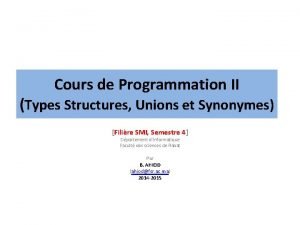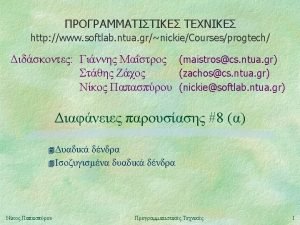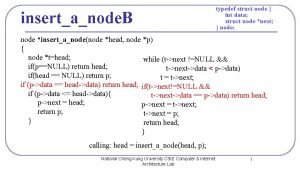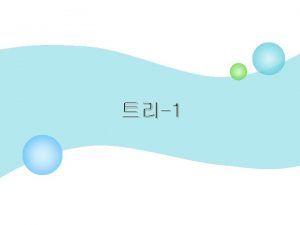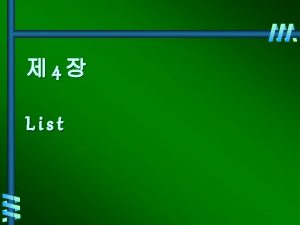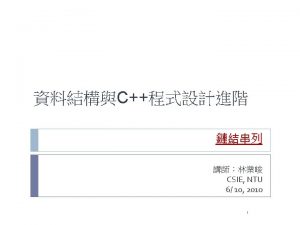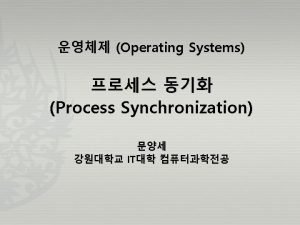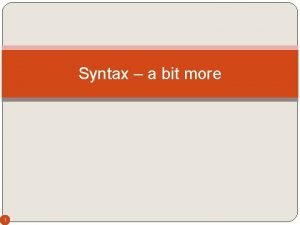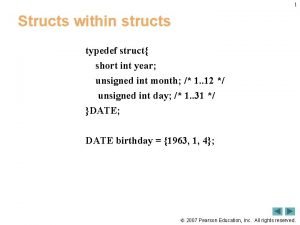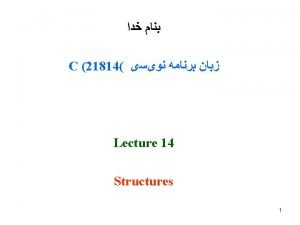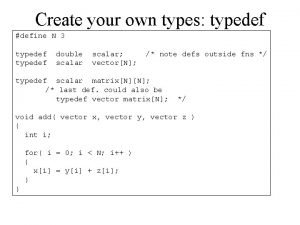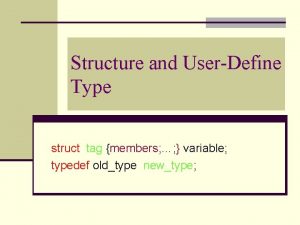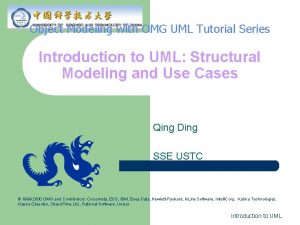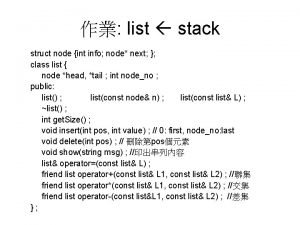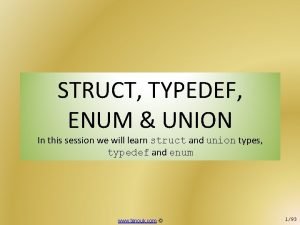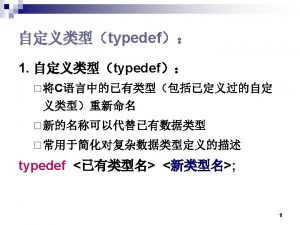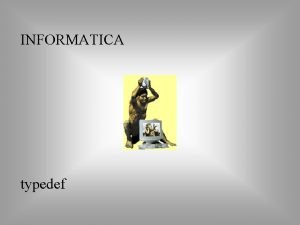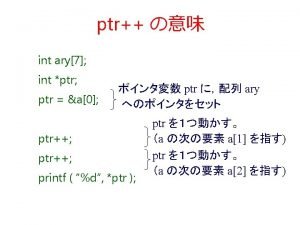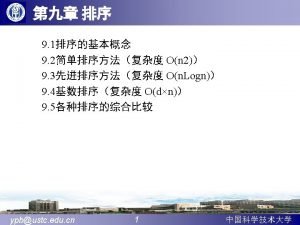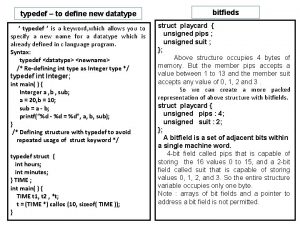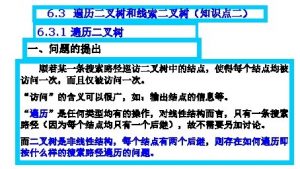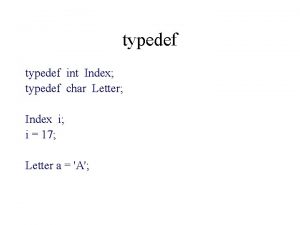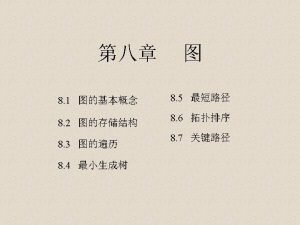2 8 1 typedef 8 1 typedef 1




















































- Slides: 52


2 8. 1 형 정의 typedef • (예 8. 1) typedef 정의와 선언 /* (1) 정의 */ typedef int BOOL; typedef unsigned char TEXT; typedef int INCHES, FEET, YARDS; typedef int vector[10]; typedef char *string; /* (2) 선언 */ BOOL flag; TEXT buf[100]; INCHES length, width; vector a, b; string text, input; /* /* /* int flag; 와 같은 의미 */ unsigned char buf[100]; 와 같은 의미 */ int length, width; 와 같은 의미 */ int a[10], b[10]; 과 같은 의미 */ char *text, *input; 과 같은 의미 */ <typedef와 #define의 차이점> - typedef는 자료형에 대해서만 기호 이름을 부여 할 수 있다. - typedef는 전처리기가 아닌 컴파일러에 의해 실행된다. (예 8. 1) typedef

3 8. 1 형 정의 typedef • (예 8. 2) typedef의 사용(1) /* (1) 정의 */ #define N 3 /* 벡터(vector)와 행렬(matrix)의 크기 */ typedef double scalar; typedef scalar vector[N]; typedef scalar matrix[N][N]; void add(a, b, c) vector a, b, c; /* double a[3], b[3], c[3]; 과 같은 의미 */ { int i; for (i = 0; i < N; i++) a[i] = b[i] + c[i]; } - 함수 add()는 벡터를 연산하는 함수이다. - matrix의 선언은 기 정의된 vector를 사용하면 다음과 같이도 할 수 있다. typedef vector matrix[N]; (예 8. 2) typedef의 사용

4 8. 1 형 정의 typedef • (예 8. 3) typedef의 사용(2) scalar dot_product(a, b) /* 벡터 a와 벡터 b의 내적(dot product) */ vector a, b; { int i; scalar s = 0; for (i = 0; i < N; i++) s += a[i] * b[i]; return s; } void multiply(a, b, c) /* 행렬 곱셈: a = b*c */ matrix a, b, c; { int i, j, k; for (i = 0; i < N; i++) for (j = 0; j < N; j++) for (c[i][j] = 0, k = 0; k < N; k++) c[i][j] += a[i][k] * b[k][j]; } - 벡터의 내적 구하는 dot_product와 두 행렬의 곱을 계산하는 multiply - scalar, vector의 정의는 예8. 2에서 정의 - matrix a, b, c; 는 double a[N][N], b[N][N], c[N][N]; 과 동일. (예 8. 3) typedef의 사용











15 8. 2 구조형 struct • (예 8. 10 계속) 구조형의 초기화 – (2)는 다음과 동일하다. /* (2)’ */ static struct month { char *mname; int day; } month_tab[] = { {“January”, 31}, {“March”, 31}, {“May”, 31}, {“July”, 31}, {“September”, 30}, {“November”, 30}, (예 8. 10 계속) 구조형의 초기화 {“February”, {“April”, {“June”, {“August”, {“October”, {“December”, 28}, 30}, 31}, 31} };



18 8. 2 구조형 struct – (예 8. 12) 간접 멤버 연산자 -> 의 사용 예 • 구조형 포인터 변수 p에 구조형 변수 temp의 포인터를 배 정하여 사용하고 있다. • p -> grade는 p가 가리키는 구조형의 멤버 grade를 뜻함. /* (예 8. 12) */ struct student temp, *p = &temp; temp. grade = ‘A’; temp. student_name = “Chanho Park”; temp. student_id = 90118; 수식 연산 우선 순위 결과 temp. student_name temp. grade temp. student_id (*p) -> student_name+2 *p -> student_name+2 *(p -> student_name+2) p -> student_name p -> grade p -> student_id *((*p) -> student_name) + 2 *(p -> student_name) + 2 p -> student_name [2] Chanho Park A 90118 /* 에러 */ E a (예 8. 12) -> 의 사용





23 8. 3 구조형과 함수 • 포인터 기반 함수와 구조형 기반 함수 – 다음 구조형을 정의하여 사용하자. 1 2 3 4 5 6 /* File : complex. h For prog 8 -16. c & prog 8 -17. c */ typedef struct { float re; float im; } complex; 헤더 file complex. h


25 8. 3 구조형과 함수 • (예 8. 16 계속) 17 18 19 20 void prnt(complex *cp) { printf(“%. 3 f + %. 3 f in”, cp->re, cp->im); } 21 22 23 24 25 26 27 28 int main(void) { complex c 1, c 2, c 3; assign(&c 1, 1. 0, 2. 0); assign(&c 2, 3. 0, 4. 0); add(&c 1, &c 2, &c 3); prnt(&c 3); } (예 8. 16 계속) output 4. 000 + 6. 000 i




29 8. 4 공용형 union • (예 8. 20) 구조형과 공용형의 혼용 – union fromwhere은 foreign_traveller와 korean_traveller 라는 멤버를 가진다. – 이 두 멤버는 동시에 사용되지 않으므로 공용형 멤버로 정의되었다. /* (예 8. 20) */ struct foreign_traveller { int country_code; int city_code; *pc; char passport_id[20]; }; struct korean_traveller { int district_code; char resident_id[13]; }; union fromwhere { struct foreign_traveller f_trav; struct korean_traveller k_trav; }; (예 8. 20) struct와 union의 혼용

30 8. 4 공용형 union • (예 8. 20 계속) 구조형과 공용형의 혼용 – traveller_record란 구조형의 한 멤버로 union fromwhere 형을 사용하고 있다. /* (예 8. 20 계속) */ typedef struct { int serial_no; char name[10]; short iskorean; union fromwhere a; } traveller_record; (예 8. 20 계속)





35 /* 예제 8. 2(계속) */ /* (4) */ struct employee student, faculty, staff; 예제 8. 2(계속) /* (5) */ struct sample { char c; float *pf; struct sample *next; } x; /* (6) */ struct { unsigned icon : 8; unsigned color : 4; unsigned underline : 1; unsigned blink : 1; } screen[25][80]; - (4) 변수 student, faculty, staff를 struct employee형으로 선언 - (5) 구조형의 3째 멤버 next는 동일한 구조형 자료에 대한 포인터이다. - (6) screen이라는 이름의 구조형 배열로 원소는 2000개이다. 각 원소는 4개의 멤버로 구성되고, 각 멤버는 각각 길이가 8비트, 4비트, 1비트이다. [해 설]


1 2 3 4 5 6 7 8 9 10 11 12 13 14 15 16 17 18 19 20 21 22 23 24 /* File : ex 8 -4. c 복소수 계산 프로그램 */ #include <stdio. h> #define CMPLX struct complex CMPLX { double re; double im; }; int main(void) { static CMPLX za = {3. 0, 4. 0}; static CMPLX zb = {5. 0, 6. 0}; CMPLX z, cadd(), cmult(); void cprint(); z = cadd(za, zb); cprint(z); z = cmult(za, zb); cprint(z); } /* ------ 복소수 덧셈 ------ */ CMPLX cadd(CMPLX za, CMPLX zb) { CMPLX z; z. re = za. re + zb. re; z. im = za. im + zb. im; return z; } 37 예제 8. 4

25 26 27 28 29 30 31 32 33 34 35 36 37 /* ------ 복소수 곱셈 ------ */ CMPLX cmult(CMPLX za, CMPLX zb) { CMPLX z; z. re = za. re * zb. re - za. im * zb. im; z. im = za. re * zb. im + za. im + zb. re; return z; } /* ------ 복소수 출력 ------ */ void cprint(CMPLX z) { printf(“%. 3 f + %. 3 f in”, z. re, z. im); } - 줄4로 CMPLX를 struct complex와 같게 선언함. - 복소수를 실수부 re(real)와 허수부 im(imaginary)로 구성된 구조형으로 정의. - 두 복소수의 합과 곱을 구하는 프로그램 8. 000 + 10. 000 i -9. 000 + 38. 000 i 38 예제 8. 4(계 속) [해 설] output

1 2 3 4 5 6 7 8 9 10 11 12 13 14 15 16 17 18 19 20 21 /* File : ex 8 -5. c struct와 내포된 struct */ #include <stdio. h> int main(void) { static struct s 1 { char c[4], *s; } s 1 = {“abc”, “def” }; static struct s 2 { char *cp; struct s 1 ss 1; } s 2 = {“ghi”, { “jkl”, “mno” }}; printf(“s 1. c[0]=%ct”, s 1. c[0]); printf(“*s 1. s=%cn”, *s 1. s); printf(“s 1. c=%st”, s 1. c); printf(“s 1. s=%sn”, s 1. s); printf(“s 2. cp=%st”, s 2. cp); printf(“s 2. ss 1. s=%sn”, s 2. ss 1. s); printf(“++s 2. cp=%st”, ++s 2. cp); printf(“++s 2. ss 1. s=%sn”, ++s 2. ss 1. s); } - struct의 멤버로 struct를 사용할 수 있다. s 1. c[0]=a s 1. c=abc s 2. cp=ghi ++s 2. cp=hi *s 1. s=def s 2. ss 1. s=mno ++s 2. ss 1. s=no 39 예제 8. 5 [해 설] output

1 2 3 4 5 6 7 8 9 10 11 12 13 14 15 16 17 18 19 20 21 22 23 24 25 26 27 28 /* File : ex 8 -6. c struct의 포인터를 인수로 사용하는 함수 match */ #include <stdio. h> struct student { char name[20]; int id; } student = { “Kim”, 73 }; int main(void) { int id, match(); char *name 1 = “Lee”, *name 2 = “Kim”; if (id = match(&student, name 1)) printf(“%s’s ID is %d. n”, name 1, id); else printf(“He is not %s. n”, name 1); if (id = match(&student, name 2)) printf(“%s’s ID is %d. n”, name 2, id); else printf(“He is not %s. n”, name 2); } int match(struct student *r, char *n) { if (strcmp(r->name, n) == 0) return r->id; return 0; /* 실패 */ } 40 예제 8. 6 struct의 포인터를 인 수로 사용




1 2 3 4 5 6 7 /* File : ex 8 -8. c struct의 복사 함수 */ #include <stdio. h> struct st { int id; char name[10]; }; 8 9 10 11 12 13 14 15 16 17 18 19 void st_copy(struct st *s 1, struct st *s 2) { int j; s 1 -> id = s 2 -> id; for (j = 0; j < 10; j++) s 1 -> name[j] = s 2 -> name[j]; } void st_print(struct st *s) { printf(“번호 = %d, 이름 = %sn”, s -> id, s -> name); } 20 44 예제 8 -8







51 /* 예제 8. 13 다음 구조형 선언의 기억 형태는? */ struct { unsigned icon: 8; unsigned color: 4; unsigned underline: 1; unsigned blink: 1; } screen[25][80]; - screen 의 2000개 원소 중 첫 번째 원소의 저장 모습이다. 14비트 크기 임. 예제 8. 13 [해 설]

1 /* File : ex 8 -14. c 2 비트 필드 조작 프로그램 */ 3 #include <stdio. h> 4 int main(void) 5 { 6 struct { 7 unsigned carry: 2; /* overflow */ 8 unsigned parity: 2; /* 1 = 짝수; 0 = 홀수 */ 9 unsigned acarry: 2; /* 보조 carry */ 10 unsigned zero: 1; /* 결과가 0 */ 11 unsigned sign: 1; /* 결과가 음수 */ 12 } f 8080; 13 f 8080. carry = f 8080. acarry = f 8080. sign = 0; 14 f 8080. parity = f 8080. zero = 1; 15 if (f 8080. carry == 0) printf(“carry 없음n”); 16 if (f 8080. parity == 0) printf(“짝수 parityn”); 17 if (f 8080. acarry == 0) printf(“보조 carry 없음n”); 18 if (f 8080. zero == 0) printf(“결과가 0이 아님n”); 19 if (f 8080. sign == 0) printf(“결과가 양수임n”); 20 } carry 없음 보조 carry 없음 결과가 양수임 52 예제 8 -14 output
 Typedef
Typedef 생능출판사 교수 아이디
생능출판사 교수 아이디 Typedef struct tree int info struct *left
Typedef struct tree int info struct *left Typedef struct in c
Typedef struct in c Int tree
Int tree Typedef struct student
Typedef struct student Typedef struct node
Typedef struct node Typedef struct in c
Typedef struct in c C typedef enum
C typedef enum Typedef struct
Typedef struct Typedef struct tree int info
Typedef struct tree int info Forward declaration of typedef
Forward declaration of typedef Typedef float
Typedef float Typedef in structure
Typedef in structure Typedef struct node
Typedef struct node Struct c
Struct c Typedef
Typedef Typedef struct c
Typedef struct c Typedef struct tag
Typedef struct tag Graphnn
Graphnn Uml
Uml Typedef int
Typedef int Typedef struct tree int info
Typedef struct tree int info Typedef struct tree int info
Typedef struct tree int info Typedef union
Typedef union
